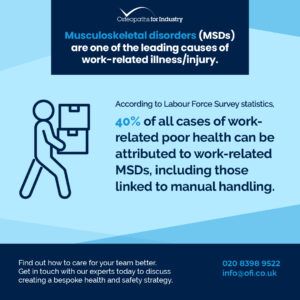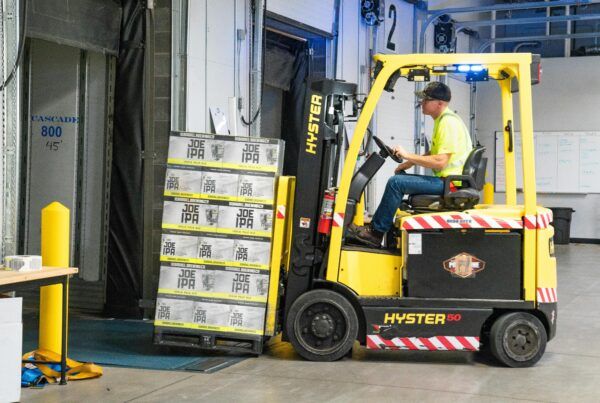Manual handling injuries and musculoskeletal disorders (MSDs) can present cause for concern in almost any workplace setting. However, in this guide to manual handling, we’re giving you all the information you need to know about manual handling injuries, including how to prevent them, how to comply with the laws and regulations surrounding manual handling injuries and work-related MSDs, and how to manage them by taking the whole picture into account. Adopting the best practices to identify and prevent risk during everyday manual handling tasks will help you create a safe environment for your employees, improving productivity and happiness at work.
Understanding Manual Handling Injuries
Definition of Musculoskeletal Disorders (MSDs):
Manual handling injuries arise in the form of musculoskeletal disorders.
Musculoskeletal disorders (or MSDs) refer to a range of injuries, damage, or conditions affecting joints and tissues in the upper/lower limbs or the back. The most common reasons for the development of MSDs are work-related activities, external factors, or illnesses.
Diverse Impacts of MSDs:
MSDs can have varying levels of impacts on an individual’s life. While some people might experience minor discomfort and still be able to continue normal activities, others may require adjustments to their workplace or even extended time off for recovery. Many MSDs resolve quickly and don’t require much treatment. However, others can cause long-lasting health issues that can majorly affect an employee’s ability to work, including conditions like carpal tunnel syndrome or tendonitis. Recognising this diversity of experience when formulating effective preventative strategies to keep your team safe is essential.
The Magnitude of the Issue
Labour Force Survey (LFS) Statistics:
According to LFS estimates, work-related MSDs, including those arising from manual handling, contribute to approximately 40% of all work-related ill health cases. Acknowledging this prevalence is crucial for devising targeted preventative measures.

Contributing Factors:
Beyond manual handling, heavy manual labour, awkward postures, and pre-existing injuries can all heighten an employee’s risk of developing a work-related MSD. Understanding these factors is foundational to the formation of a comprehensive approach towards injury prevention.
Proactive Measures for Prevention
Regulatory Compliance
Adhering to the Manual Handling Operations Regulations is essential for creating a safe work environment. These emphasise your responsibility to avoid hazardous manual handling wherever possible by taking active measures to avoid, assess, and mitigate injury risks.
Periodic Risk Assessments
Regular reviews of risk assessments are imperative to adapt to evolving workplace dynamics and ensure the ongoing effectiveness of safety measures. Employers should employ risk filters for tasks that are generally low risk, while high risk tasks should be avoided or mechanised entirely.
At OFI, we can provide risk assessments for your staff and/or train members of your team to become in-house risk assessors. It’s our job to help you pre-emptively identify risk factors and prevent injuries to your staff.
At the forefront of our field for over 36 years, we’re experts in providing in-depth assessments on:
Early Symptom Reporting
Encouraging employees to report symptoms promptly allows for timely intervention, which can be key to preventing the escalation of injuries and pain levels. Employers should establish clear and easy-to-use health monitoring systems to encourage staff to communicate any issues as and when they arise.
Effective Injury Management
Cases of manual handling injuries should be managed with efficiency and compassion, creating an environment conducive to recovery.
Workforce Consultation and Involvement
Engaging employees and their representatives to collaborate when identifying risks and finding solutions not only enhances safety but also promotes a culture of shared responsibility.
Getting to Grips with the Rules and Regulations
Requirements of the Manual Handling Operations Regulations
Employers are mandated to avoid hazardous manual handling, assess risks, and reduce the risk level to an extent which is reasonably practicable. The term “reasonably practicable” involves balancing risk levels against the measures required whilst also considering factors like time, money, and effort.
Integration with Health and Safety Management
Managing risks from manual handling operations should seamlessly align with an organisation’s broader health and safety responsibilities. The ‘Plan, Do, Check, Act’ approach provides a structured framework for effective risk management.
Beyond Weight Limits: An Ergonomic Approach
The Regulations do not prescribe specific weight limits but underscore the importance of considering multiple risk factors. An ergonomic approach, incorporating the nature of the task, the load, the working environment, and individual capabilities, forms the cornerstone of injury prevention.
Psychosocial Risk Factors
In addition to physical considerations, psychosocial elements such as workload, deadlines, and control over work conditions play a pivotal role in preventing manual handling injuries. A holistic approach should take into account both physical and mental well-being.
Employee Consultation and Engagement

The Importance of Employee Consultation
Consulting employees on health and safety matters is not only a legal requirement but a must for a healthier, happier, more connected and communicative workplace! In workplaces with recognised trade unions, consultation is facilitated through union health and safety representatives.
Employee Insight into Manual Handling Risks
As they possess first-hand knowledge of the workplace dynamics they navigate daily, employees can contribute valuable insights into manual handling risks. Their input can help you create practical solutions tailored to the specific challenges of their working environment.
Did You Know?
The incidence of Hand-Arm Vibration Syndrome cases in the UK has declined from 1,210 per year in 2010 to 300 per year in 2022. This is largely a result of improved training provision and early reporting systems.
Deconstructing Risk Assessment Filters
Tailoring Assessments to Specific Needs
Employers are legally obliged to assess the risks associated with their team’s engagement in manual handling operations. A nuanced approach involving various risk assessment filters ensures that attention is concentrated where it is most needed.
Simple Weight Filters
Basic weight-based filters assume infrequent handling, symmetrical processes, and favourable working conditions. These filters serve as a preliminary assessment tool.
Detailed Assessment with Tools
Utilising tools such as HSE’s Manual Handling Assessment Charts (MAC tool) facilitates a more in-depth analysis, considering common risk factors associated with manual handling.
Full Risk Assessment
When preliminary assessments fall short, a comprehensive risk assessment encompassing all factors outlined in Schedule 1 of the Regulations, becomes necessary. Employers can choose from various assessment methods, ensuring suitability and sufficiency.
Additional Resources for Enhanced Risk Management
Upper Limb Disorders
Where risks to upper limbs are identified, resources such as the HSE leaflet on Managing Upper Limb Disorders in the Workplace provide valuable insights. Detailed guidance on upper limb disorders is also available for industry-specific situations.
Repetitive Tasks
For repetitive tasks impacting upper limbs, the ART tool and HSE’s resources on managing back pain in the workplace can be helpful.
In Summary
The prevention and management of manual handling injuries demands a multifaceted approach, which includes compliance with regulations, carrying out ongoing risk assessments, engaging employees and involving them in the process, and committing to overall health and safety management. By embracing these ideals, organisations can create a culture of safety, reduce the incidence of manual handling injuries, and cultivate a workplace that prioritises its employees’ wellbeing.








